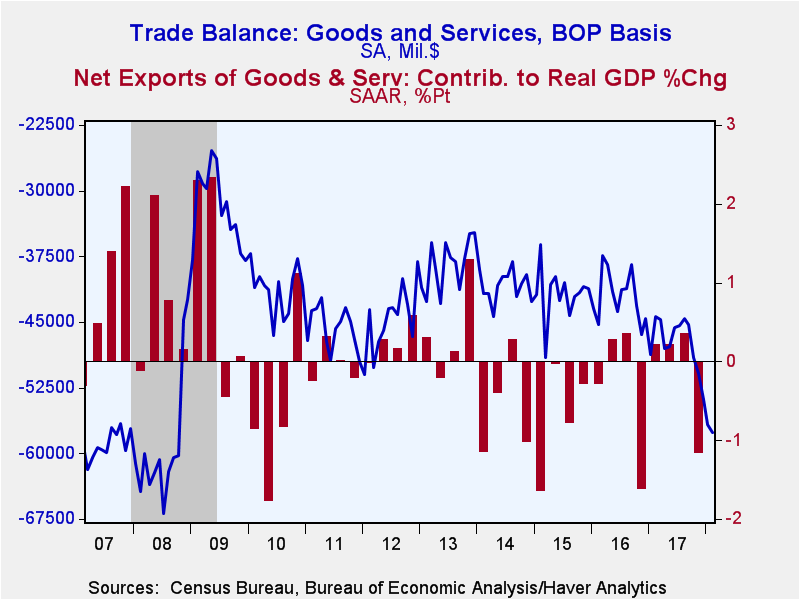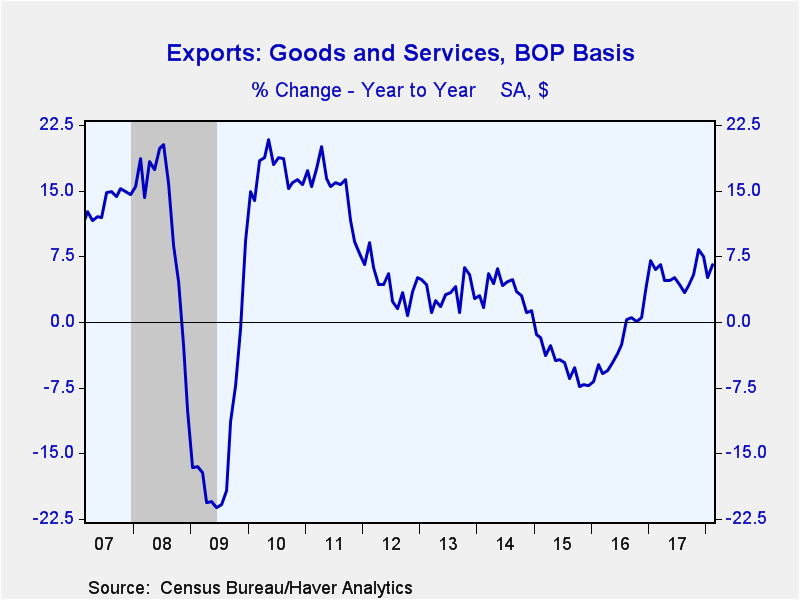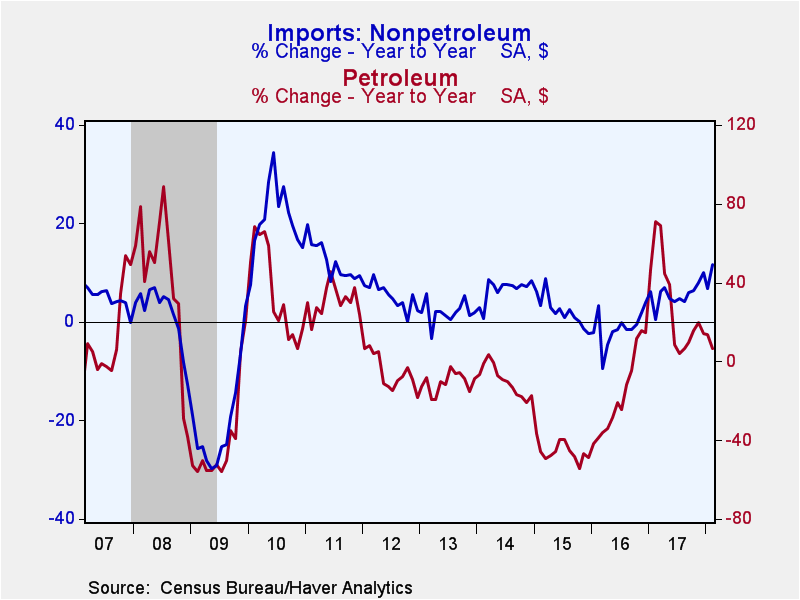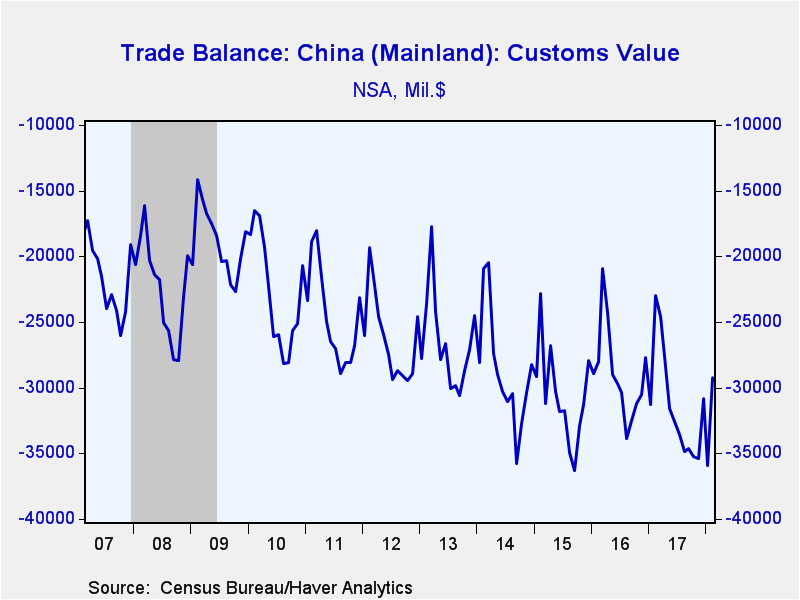 Global| Apr 05 2018
Global| Apr 05 2018U.S. Trade Deficit Increases to Highest Since 2008
by:Tom Moeller
|in:Economy in Brief
Summary
The U.S. trade deficit in goods and services widened to $57.6 billion during February from $56.7 billion in January, revised from $56.6 billion. It was the largest deficit since October 2009. A $56.7 billion deficit had been expected [...]
The U.S. trade deficit in goods and services widened to $57.6 billion during February from $56.7 billion in January, revised from $56.6 billion. It was the largest deficit since October 2009. A $56.7 billion deficit had been expected in the Action Economics Forecast Survey. Exports increased 1.7% (6.6% y/y) following a 1.3% decline while imports also rose 1.7% (10.9% y/y) after no change.
The deficit on goods trade increased to $77.0 billion, the biggest since July 2008. Exports of goods gained 2.3% (7.5% y/y) following a 2.2% decline. A 6.7% rise (9.1% y/y) in exports of motor vehicles & parts led the increase as it followed a 3.6% gain. Exports in industrial supplies & materials gained 4.9% (13.4% y/y) after a 3.2% decline. Capital goods exports were up 1.5% (6.5% y/y) on the heels of a 5.4% decline. Foods, feeds & beverage exports ticked 0.1% higher (4.2% y/y) after a 0.7% decline. Exports of nonauto consumer goods declined 4.7% (+0.4% y/y) following a 7.0% rise.
 Imports of goods increased 1.7% in February (11.1% y/y)
following a 0.1% easing. Foods, feeds & beverage imports surged 6.5% (12.2%
y/y) after a 0.1% dip. Capital goods imports recovered 3.3% (13.4% y/y)
following a 2.3% decline. Industrial supplies & materials imports gained
1.7% (9.5% y/y) after a 4.4% jump. Nonauto consumer product imports rose 0.9%
(13.7% y/y) following a 1.6% decline. Motor vehicle & parts imports gained
0.5% (7.1% y/y) after a 0.1% uptick.
Imports of goods increased 1.7% in February (11.1% y/y)
following a 0.1% easing. Foods, feeds & beverage imports surged 6.5% (12.2%
y/y) after a 0.1% dip. Capital goods imports recovered 3.3% (13.4% y/y)
following a 2.3% decline. Industrial supplies & materials imports gained
1.7% (9.5% y/y) after a 4.4% jump. Nonauto consumer product imports rose 0.9%
(13.7% y/y) following a 1.6% decline. Motor vehicle & parts imports gained
0.5% (7.1% y/y) after a 0.1% uptick.
All non-petroleum goods imports increased 1.7% (11.6% y/y) after a 1.6% decline. Petroleum imports increased 1.3% (6.4% y/y) following January's 20.8% jump. The per barrel cost of crude oil eased to $54.61 (+20.7% y/y) from the highest level since January 2015. Nevertheless, the value of energy-related petroleum product imports declined 17.0% (+5.0% y/y) after a 20.8% jump. The quantity of energy-related product imports fell 17.1% (-12.9% y/y) after a 14.9% rise.
The surplus on services trade declined to $19.4 billion in February from $20.0 billion and compared to $20.9 billion surplus in February 2017. Services exports increased 0.7% (4.8% y/y) after a 0.6% rise. Travel exports increased 0.7% (-0.1% y/y) after a 1.0% increase. Charges for the use of intellectual property gained 0.7% (13.6% y/y) after a 0.8% rise. Transport exports gained 2.3% (6.1% y/y) following a 0.9% rise.
Imports of services strengthened 2.3% (10.6% y/y) after a 0.3% advance. Charges for the use of intellectual property surged 23.3% (34.0% y/y) after a 0.9% gain. U.S. residents' travel abroad declined 1.4% (+3.7% y/y) following a 2.1% retreat. Transport charges rose 1.3% (6.8% y/y) for a second straight month.
By country, the goods trade deficit with China narrowed to $29.3 billion in February (NSA) after $36.0 billion in January. Exports rose 0.1% y/y and imports jumped 10.2% y/y. The deficit with the European Union narrowed to $12.0 billion (NSA) from $13.6 billion. Exports increased 8.6% y/y and imports rose 14.3% y/y. The trade deficit with Japan eased to $5.5 billion as exports rose 2.2% y/y and imports increased 9.6% y/y.
The international trade data can be found in Haver's USECON database. Detailed figures are available in the USINT database. The expectations figures are from the Action Economics Forecast Survey, which is carried in AS1REPNA.
| Foreign Trade in Goods & Services (Current Dollars) | Feb | Jan | Dec | Y/Y | 2017 | 2016 | 2015 |
|---|---|---|---|---|---|---|---|
| U.S. Trade Deficit | $57.6 bil. | $56.7 bil. | $53.9 bil. | $48.4 bil. (2/17) |
$568.4 bil. | $504.8 bil. | $500.4 bil. |
| Exports of Goods & Services (% Chg) | 1.7 | -1.3 | 1.7 | 6.6 | 5.6 | -2.5 | -4.7 |
| Imports of Goods & Services (% Chg) | 1.7 | 0.0 | 2.6 | 10.9 | 6.9 | -1.9 | -3.6 |
| Petroleum (% Chg) | 1.3 | 20.8 | -6.2 | 6.4 | 27.0 | -19.4 | -45.5 |
| Nonpetroleum Goods (% Chg) | 1.7 | -1.6 | 3.7 | 11.6 | 5.7 | -1.2 | 2.2 |
Tom Moeller
AuthorMore in Author Profile »Prior to joining Haver Analytics in 2000, Mr. Moeller worked as the Economist at Chancellor Capital Management from 1985 to 1999. There, he developed comprehensive economic forecasts and interpreted economic data for equity and fixed income portfolio managers. Also at Chancellor, Mr. Moeller worked as an equity analyst and was responsible for researching and rating companies in the economically sensitive automobile and housing industries for investment in Chancellor’s equity portfolio. Prior to joining Chancellor, Mr. Moeller was an Economist at Citibank from 1979 to 1984. He also analyzed pricing behavior in the metals industry for the Council on Wage and Price Stability in Washington, D.C. In 1999, Mr. Moeller received the award for most accurate forecast from the Forecasters' Club of New York. From 1990 to 1992 he was President of the New York Association for Business Economists. Mr. Moeller earned an M.B.A. in Finance from Fordham University, where he graduated in 1987. He holds a Bachelor of Arts in Economics from George Washington University.










